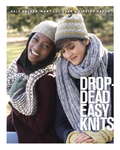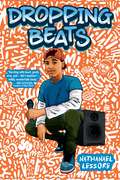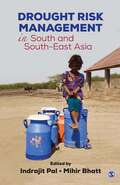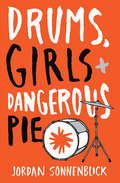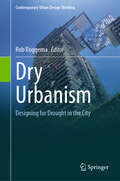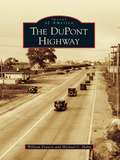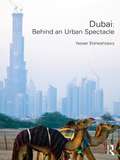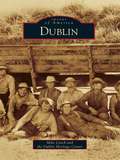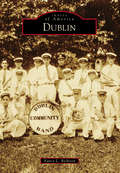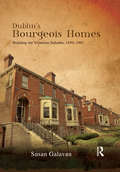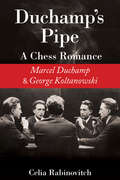- Table View
- List View
Drop That Knowledge: Youth Radio Stories
by Vivian Chavez Lissa soepThis is the first book to take us inside Youth Radio for a fascinating, behind-the-scenes look at a unique, Peabody Award-winning organization that produces distinctive content for outlets from National Public Radio to YouTube. Young people come to Youth Radio, headquartered in Oakland, California, from under-resourced public schools and neighborhoods in order to produce media that will transform both their own lives and the world around them. Drop That Knowledge weaves their compelling personal stories into a fresh framework for understanding the relationship between media, learning, and youth culture at a moment when all three spheres are undergoing dramatic change. The book emphasizes what is innovative and exciting in youth culture and offers concrete strategies for engaging and collaborating with diverse groups of young people on real-world initiatives in a range of settings, online and in real life.
Drop-Dead Easy Knits
by Gale Zucker Kirsten Kapur Mary Lou EganFinally, a knitting book featuring fantastic projects that don't require you to study a pattern for hours--a sure recipe for blissful, carefree knitting. A book of great potential gifts and keepsakes, this collection of 30 dynamic projects--from blankets to simple sweaters to wraps--is designed so you can easily pick up your needles during moments of free time, whether binge-watching a show, waiting for your plane to board, or having a "wine and knitting" night with friends. For key moments--such as joining an arm to a sweater or casting on additional rows--patterns are coded with "concentration zones" and "cruise control" segments for when you can go into a mindful state and let the knitting take a back seat. Thin enough to slip in your bag, with charming four-color photography throughout, Drop-Dead Easy Knits is the answer to all your laid-back knitting needs.
Drop-Dead Easy Knits
by Gale Zucker Kirsten Kapur Mary Lou EganFinally, a knitting book featuring fantastic projects that don't require you to study a pattern for hours--a sure recipe for blissful, carefree knitting. A book of great potential gifts and keepsakes, this collection of 30 dynamic projects--from blankets to simple sweaters to wraps--is designed so you can easily pick up your needles during moments of free time, whether binge-watching a show, waiting for your plane to board, or having a "wine and knitting" night with friends. For key moments--such as joining an arm to a sweater or casting on additional rows--patterns are coded with "concentration zones" and "cruise control" segments for when you can go into a mindful state and let the knitting take a back seat. Thin enough to slip in your bag, with charming four-color photography throughout, Drop-Dead Easy Knits is the answer to all your laid-back knitting needs.
Drop-Dead Easy Knits
by Gale Zucker Kirsten Kapur Mary Lou EganFinally, a knitting book featuring fantastic projects that don't require you to study a pattern for hours--a sure recipe for blissful, carefree knitting. A book of great potential gifts and keepsakes, this collection of 30 dynamic projects--from blankets to simple sweaters to wraps--is designed so you can easily pick up your needles during moments of free time, whether binge-watching a show, waiting for your plane to board, or having a "wine and knitting" night with friends. For key moments--such as joining an arm to a sweater or casting on additional rows--patterns are coded with "concentration zones" and "cruise control" segments for when you can go into a mindful state and let the knitting take a back seat. Thin enough to slip in your bag, with charming four-color photography throughout, Drop-Dead Easy Knits is the answer to all your laid-back knitting needs.
Dropping Beats
by Nathanael Lessore"Funny, bursting with heart, goofy, wise, and did I mention– wildly wonderfully funny." —Jon Scieszka, First National Ambassador of Young People's Literature and Founder of Guys ReadA hilarious and heartfelt young YA comedy about the misadventures of an aspiring young rapper as he navigates school, family, and friendship. Thirteen-year-old Growls (aka Shaun) is an aspiring (awful) rapper who hopes to enter this year&’s Raptology competition with his best friend, Shanks (aka Zachariah). After all, what better way to land his crush (Tanisha) and get the respect he finally deserves than winning the contest and going viral? But when a livestream practice goes epically wrong, the two friends do go viral– and not in the way they&’d hoped. Now the laughingstock of the school, Growls is sure he&’ll never have another chance to date Tanisha. Even worse, Shanks has gone MIA, leaving him terribly alone. But when Growls meets the new girl on the block (Siobhan), things don&’t seem so terrible after all. And with some patience, a little luck, and a whole lot of practice, he just might win the Raptology competition and be a hero to both Siobhan and Shanks. Either way, he&’s ready for this. He&’s steady for this. It&’s comeback season and they call him comeback king for a reason.
Drought Risk Management in South and South-East Asia
by Indrajit Pal and Mihir BhattThe geo-climatic conditions of South and South-East Asian countries are diverse and vulnerable to multiple natural hazards such as drought. Drought evolves over months or even years, affects a large spatial extent and causes enormous damages. Drought Risk Management in South and South-East Asia is a comprehensive reference on overall perspectives and scenarios on drought risk mitigation and management, based on researches and case studies from South and South-East Asian countries. Drought management is a complex area of work that requires active and continuous participation of the national, provincial and local governments, multiple ministries, and divisions. This book demonstrates the best practices of socio-economic and technological interventions to enhance drought risk management, which will help to develop plans and policies, and their implementation to reduce the impact of droughts. It also offers views of field practitioners on impacts of the interventions practised at the national, sub-national and local levels.
Drugs, Thugs, and Divas
by O. Hugo BenavidesSoap opera speaks a universal language, presenting characters and plots that resonate far beyond the culture that creates them. Latin American soap operas - telenovelas - have found enthusiastic audiences throughout the Americas and Europe, as well as in Egypt, Russia, and China, while Mexican narco-dramas have become highly popular among Latinos in the United States. In this first comprehensive analysis of telenovelas and narco-dramas, Hugo Benavides assesses the dynamic role of melodrama in creating meaningful cultural images to explain why these genres have become so successful while more elite cultural productions are declining in popularity. Benavides offers close readings of the Colombian telenovelas Betty la fea (along with its Mexican and U. S. reincarnations La fea más bella and Ugly Betty), Adrián está de visita, and Pasión de gavilanes; the Brazilian historical telenovela Xica; and a variety of Mexican narco-drama films. Situating these melodramas within concrete historical developments in Latin America, he shows how telenovelas and narco-dramas serve to unite peoples of various countries and provide a voice of rebellion against often-oppressive governmental systems. Indeed, Benavides concludes that as one of the most effective and lucrative industries in Latin America, telenovelas and narco-dramas play a key role in the ongoing reconfiguration of social identities and popular culture.
Drums, Girls, and Dangerous Pie
by Jordan SonnenblickA brave and beautiful story that will make readers laugh, and break their hearts at the same time. Now with a special note from the author!Steven has a totally normal life (well, almost).He plays drums in the All-City Jazz Band (whose members call him the Peasant), has a crush on the hottest girl in school (who doesn't even know he's alive), and is constantly annoyed by his younger brother, Jeffrey (who is cuter than cute - which is also pretty annoying). But when Jeffrey gets sick, Steven's world is turned upside down, and he is forced to deal with his brother's illness, his parents' attempts to keep the family in one piece, his homework, the band, girls, and Dangerous Pie (yes, you'll have to read the book to find out what that is!).
Dry Run
by Jerry YudelsonIn the Age of Scarcity now upon us, fresh water shortages are an increasingly serious global problem. With water restrictions emerging in many developed countries and water diversions for industrial, urban, and environmental reasons stirring up oceans of controversy, there is a growing thirst for innovative approaches to reducing our water footprint. Dry Run shows the best ways to manage scarce water resources and handle upcoming urban water crises. Featuring original interviews with more than twenty-five water researchers and industry experts, this book explains water issues and proposes solutions for homes, buildings, facilities, and schools. Examining the vital linkages between water, energy use, urban development, and climate change, Dry Run demonstrates best practices for achieving "net zero" water use in the built environment, including: Water conservation strategies for buildings, factories, cities, and homes Rainwater harvesting Graywater reuse and water reclamation systems Water efficiency retrofits On-site sewage treatment New water reuse and supply technologies Ideal for concerned citizens, building managers, homeowners, architects, engineers, developers, and public officials faced with charting a course in a more arid future, Dry Run overflows with practical solutions. Jerry Yudelson, PE, LEED AP, leads the Yudelson Associates consultancy and is a leading authority on green building, clean water, and sustainable development. He is the author of eleven books, including Choosing Green and Green Building A to Z.
Dry Urbanism: Designing for Drought in the City (Contemporary Urban Design Thinking)
by Rob RoggemaThe ambition of the book is to give a contemporary insight in the state of the art when it comes to designing our cities and landscapes for dry conditions. Water, or the absence thereof, is an important issue to consider. Many cities around the world are increasingly suffering heat, droughts and occasional severe flooding and rainfall. This asks for new approaches, and methodologies to (re)design the urban and rural condition to stay livable. This book aims to connect theories (the methodologies and approaches) with practice (concrete examples and projects).
Drying and Wetting of Building Materials and Components
by J. M. P. Q. DelgadoThis book, Drying and Wetting of Building Materials and Components, provides a collection of recent contributions in the field of drying and wetting in porous building materials. The main benefit of the book is that it discusses some of the most important topics related to the drying and wetting processes, namely, innovations and trends in drying science and technology, drying mechanism and theory, equipment, advanced modelling, complex simulation and experimentation. At the same time, these topics will be going to the encounter of a variety of scientific and engineering disciplines. The book is divided in several chapters that intend to be a resume of the current state of knowledge for benefit of professional colleagues.
DuPont Highway, The
by Michael C. Hahn William FrancisThe original DuPont Highway, found on maps as Route 13 between Dover and Wilmington and as Route 113 between Dover and the southern border with Maryland, was the nation's first divided highway when its expansion between Dover and Wilmington was completed in 1934. It had been officially dedicated 10 years earlier as the Coleman DuPont Road. Thomas Coleman du Pont, a descendant of E. I. du Pont and a two-time U.S. senator, had championed the road and paid nearly $4 million of his own money toward its completion, even after turning the project over to the newly created Delaware State Highway Department. While other philanthropists started schools, libraries, parks, and hospitals, Coleman du Pont said, "I will build a monument a hundred miles high and lay it on the ground." He was close. The DuPont Highway measured 96.7 miles.
Dual Cities: Social Housing in London & New York
by Karakusevic Paul Althorpe MikeGrowing up in tandem and maturing as urban democracies during the 19th and 20th centuries, London and New York have both influenced the shape and form of cities around the world. There is much that connects the two: global ambitions, post-industrial economies and international demographics. As both cities grapple with a housing crisis, fuelled by escalating prices, ageing stock and a scarcity of genuinely affordable homes, homelessness and inequality have become entrenched. The two metropolises are united by a pressing need to address urban housing provision and social equity.Offering a practical guide to the past, present and future of housing, Dual Cities explores social and affordable housing models in London and New York. Illustrated case studies showcase best practice in parallel, demonstrating how the cities have inspired and learnt from each other. Complemented by a set of thoughtful essays and interviews with experts from both sides of the Atlantic, the book demystifies current policy, delivery mechanisms and ways of working, providing valuable lessons in creating better and more resilient cities through improved housing.Featuring: Contextual case studies, including: Alton East West, Blackfriars, Becontree and Dujardin Mews in London, and East River Houses, Riverbend City, Sunnyside and Williamsburg in New York. 20 contemporary case studies from New York and London, fully illustrated with photographs, drawings and plans. Featured projects by: Adam Khan Architects, Al-Jawad Pike, Archio, Bernheimer Architects, FXCollaborative, Karakusevic Carson Architects, Mae, Magnussen Architecture and Planning, Mary Duggan Architects and Shakespeare Gordon Studio. Expert contributors include: Abigail Batchelor, John Boughton, Patrice Derrington, Alex Ely, Moses Gates, Karen Kubey, Matthew Lasner, Brian Loughlin, David Madden and Kath Scanlon. Dual Cities is supported by the AIA New York Chapter
Dual Learning
by Tao QinMany AI (and machine learning) tasks present in dual forms, e.g., English-to-Chinese translation vs. Chinese-to-English translation, speech recognition vs. speech synthesis,question answering vs. question generation, and image classification vs. image generation. Dual learning is a new learning framework that leverages the primal-dual structure of AI tasks to obtain effective feedback or regularization signals in order to enhance the learning/inference process. Since it was first introduced four years ago, the concept has attracted considerable attention in multiple fields, and been proven effective in numerous applications, such as machine translation, image-to-image translation, speech synthesis and recognition, (visual) question answering and generation, image captioning and generation, and code summarization and generation. Offering a systematic and comprehensive overview of dual learning, this book enables interested researchers (both established and newcomers) and practitioners to gain a better understanding of the state of the art in the field. It also provides suggestions for further reading and tools to help readers advance the area. The book is divided into five parts. The first part gives a brief introduction to machine learning and deep learning. The second part introduces the algorithms based on the dual reconstruction principle using machine translation, image translation, speech processing and other NLP/CV tasks as the demo applications. It covers algorithms, such as dual semi-supervised learning, dual unsupervised learning and multi-agent dual learning. In the context of image translation, it introduces algorithms including CycleGAN, DualGAN, DiscoGAN cdGAN and more recent techniques/applications. The third part presents various work based on the probability principle, including dual supervised learning and dual inference based on the joint-probability principle and dual semi-supervised learning based on the marginal-probability principle. The fourth part reviews various theoretical studies on dual learning and discusses its connections to other learning paradigms. The fifth part provides a summary and suggests future research directions.
Dual Quaternions and Their Associated Clifford Algebras
by Ronald GoldmanClifford algebra for dual quaternions has emerged recently as an alternative to standard matrix algebra as a computational framework for computer graphics. This book presents dual quaternions and their associated Clifford algebras in a new light, accessible to and geared toward the computer graphics community. Collecting all the associated formulas and theorems in one place, this book provides an extensive and rigorous treatment of dual quaternions, as well as showing how two models of Clifford algebra emerge naturally from the theory of dual quaternions. Each section comes complete with a set of exercises to help readers sharpen and practice their understanding. This book is accessible to anyone with a basic knowledge of quaternion algebra and is of particular use to forward-thinking members of the computer graphics community.
Duanesburg and Princetown
by Duanesburg Historical SocietyDuanesburg and Princetown depicts the two westernmost hill towns of Schenectady County. Settlers arrived in the region in the mid-1700s, and eventually hamlets grew up where they clustered: Quaker Street, Delanson, Mariaville,Eaton's Corners, Braman's Corners, Duanesburg Four Corners, Rynex Corners, Gifford's, Princetown Hamlet, and Kelly's Station. Images from these hamlets provide glimpses of more than two centuries of American endeavor, including early styles of architecture and the largest coaling station in the world in 1907, natural sites of extraordinary beauty and interest, and a progression of religious, social, political,and economic activity.
Dubai: Behind an Urban Spectacle (Planning, History and Environment Series)
by Yasser ElsheshtawyYasser Elsheshtawy explores Dubai’s history from its beginnings as a small fishing village to its place on the world stage today, using historical narratives, travel descriptions, novels and fictional accounts by local writers to bring colour to his history of the city’s urban development. With the help of case studies and surveys this book explores the economic and political forces driving Dubai’s urban growth, its changing urbanity and its place within the global city network. Uniquely, it looks beyond the glamour of Dubai’s mega-projects, and provides an in-depth exploration of a select set of spaces which reveal the city’s ‘inner life’.
Dublin (Images of America)
by Mike Lynch Dublin Heritage CenterNestled in the wooded hills east of the San Francisco Bay, Dublin's sprawling valley has welcomed people from a variety of backgroundsthroughout its rich history. At the heart of the tri-valley region, this former agricultural area has grown exponentially over the years, forming a moderncity with a solid community-oriented heritage. From California's first native inhabitants, through the Spanish and Mexican periods, to the arrival of the first American settlers, Dublin has long been at the crossroads of culture and settlement.
Dublin (Images of America)
by Nancy L. RichisonThroughout history, the city of Dublin's rich, verdant land has attracted settlers and visitors alike. Native Americans first inhabited the area in the days before the US government gave Continental Army soldiers property along the banks of the Scioto River as payment for service in the Revolutionary War. Platted as a village in 1810, Dublin's early settlers included John Sells, who offered surveyor John Shields the privilege of naming the new settlement. Legend has it that the lush vegetation prompted Shields to bestow the name of his homeland: Dublin, Ireland. Dublin, Ohio, would remain a sleepy little burg until the 1960s and 1970s, when three major changes led to explosive growth: the construction of Interstate 270, the development of Jack Nicklaus's Muirfield Village Golf Club and residential neighborhood, and the arrival of Ashland, Inc. Today, Dublin is known as a golf mecca--home of the PGA Tour's Memorial Tournament--and an international corporate headquarters, with The Wendy's Company, Stanley Steemer, and Cardinal Health among its marquee businesses.
Dublin: The Emerald City (Images of America)
by Scott ThompsonAt the dawn of the twentieth century, Dublin, Georgia, was transformed from a violent and lawless community into one of the state's fastest growing, most prosperous and cultivated cities. The coming of the railroad, the prohibition of liquor sales, and evolving industries all played a part in escortingDublin into this "Golden Era," a period of unparalleled expansion and exuberance. With over two hundred historic photographs, Dublin: The Emerald City takes the reader on a journey into Dublin's storied past, tracing the major events that gave Dublin its sense of community and restored pride in its residents following years of turmoil. Included are images of the town's early homes, businesses, churches, and schools, as well as local festivals, fairs, and sports teams. Although the town's Golden Era came to an untimely end with the invasion of the boll weevil, the influenza epidemic of 1918, and the devastation of lives lost during the First World War, Dublin is still a spirited community, growing and changing with the times while reflecting upon a colorful history.
Dublin’s Bourgeois Homes: Building the Victorian Suburbs, 1850-1901
by Susan GalavanIn 1859, Dubliners strolling along country roads witnessed something new emerging from the green fields. The Victorian house had arrived: wide red brick structures stood back behind manicured front lawns. Over the next forty years, an estimated 35,000 of these homes were constructed in the fields surrounding the city. The most elaborate were built for Dublin’s upper middle classes, distinguished by their granite staircases and decorative entrances. Today, they are some of the Irish capital’s most highly valued structures, and are protected under strict conservation laws. Dublin’s Bourgeois Homes is the first in-depth analysis of the city’s upper middle-class houses. Focusing on the work of three entrepreneurial developers, Susan Galavan follows in their footsteps as they speculated in house building: signing leases, acquiring plots and sourcing bricks and mortar. She analyses a select range of homes in three different districts: Ballsbridge, Rathgar and Kingstown (now Dun Laoghaire), exploring their architectural characteristics: from external form to plan type, and detailing of materials. Using measured surveys, photographs, and contemporary drawings and maps, she shows how house design evolved over time, as bay windows pushed through façades and new lines of coloured brick were introduced. Taking the reader behind the façades into the interiors, she shows how domestic space reflected the lifestyle and aspirations of the Victorian middle classes. This analysis of the planning, design and execution of Dublin’s bourgeois homes is an original contribution to the history of an important city in the British Empire.
Duchamp Is My Lawyer: The Polemics, Pragmatics, and Poetics of UbuWeb
by Kenneth GoldsmithIn 1996, during the relatively early days of the web, Kenneth Goldsmith created UbuWeb to post hard-to-find works of concrete poetry. What started out as a site to share works from a relatively obscure literary movement grew into an essential archive of twentieth- and twenty-first-century avant-garde and experimental literature, film, and music. Visitors around the world now have access to both obscure and canonical works, from artists such as Kara Walker, Yoko Ono, Pauline Oliveros, Samuel Beckett, Marcel Duchamp, Cecil Taylor, Glenn Ligon, William Burroughs, and Jean-Luc Godard.In Duchamp Is My Lawyer, Goldsmith tells the history of UbuWeb, explaining the motivations behind its creation and how artistic works are archived, consumed, and distributed online. Based on his own experiences and interviews with a variety of experts, Goldsmith describes how the site navigates issues of copyright and the ways that UbuWeb challenges familiar configurations and histories of the avant-garde. The book also portrays the growth of other “shadow libraries” and includes a section on the artists whose works reflect the aims, aesthetics, and ethos of UbuWeb. Goldsmith concludes by contrasting UbuWeb’s commitment to the free-culture movement and giving access to a wide range of artistic works with today’s gatekeepers of algorithmic culture, such as Netflix, Amazon, and Spotify.
Duchamp and the Aesthetics of Chance: Art as Experiment
by Herbert Molderings John BrogdenMarcel Duchamp is often viewed as an "artist-engineer-scientist," a kind of rationalist who relied heavily on the ideas of the French mathematician and philosopher Henri Poincaré. Yet a complete portrait of Duchamp and his multiple influences draws a different picture. In his 3 Standard Stoppages (1913-1914), a work that uses chance as an artistic medium, we see how far Duchamp subverted scientism in favor of a radical individualistic aesthetic and experimental vision. Unlike the Dadaists, Duchamp did more than dismiss or negate the authority of science. He pushed scientific rationalism to the point where its claims broke down and alternative truths were allowed to emerge. With humor and irony, Duchamp undertook a method of artistic research, reflection, and visual thought that focused less on beauty than on the notion of the "possible. " He became a passionate advocate of the power of invention and thinking things that had never been thought before. The 3 Standard Stoppages is the ultimate realization of the play between chance and dimension, visibility and invisibility, high and low art, and art and anti-art. Situating Duchamp firmly within the literature and philosophy of his time, Herbert Molderings recaptures the spirit of a frequently misread artist--and his thrilling aesthetic of chance.
Duchamp and the Aesthetics of Chance: Art as Experiment (Columbia Themes in Philosophy, Social Criticism, and the Arts)
by Herbert MolderingsMarcel Duchamp is often viewed as an "artist-engineer-scientist," a kind of rationalist who relied heavily on the ideas of the French mathematician and philosopher Henri Poincaré. Yet a complete portrait of Duchamp and his multiple influences draws a different picture. In his 3 Standard Stoppages (1913-1914), a work that uses chance as an artistic medium, we see how far Duchamp subverted scientism in favor of a radical individualistic aesthetic and experimental vision.Unlike the Dadaists, Duchamp did more than dismiss or negate the authority of science. He pushed scientific rationalism to the point where its claims broke down and alternative truths were allowed to emerge. With humor and irony, Duchamp undertook a method of artistic research, reflection, and visual thought that focused less on beauty than on the notion of the "possible." He became a passionate advocate of the power of invention and thinking things that had never been thought before. The 3 Standard Stoppages is the ultimate realization of the play between chance and dimension, visibility and invisibility, high and low art, and art and anti-art. Situating Duchamp firmly within the literature and philosophy of his time, Herbert Molderings recaptures the spirit of a frequently misread artist-and his thrilling aesthetic of chance.
Duchamp's Pipe: A Chess Romance--Marcel Duchamp and George Koltanowski
by Celia RabinovitchArt, chess, and an $87,000 pipe frame an inside look at the relationship between Dadaist artist Marcel Duchamp and chess Grandmaster George KoltanowskiSpanning three decades, two continents, two world wars, and the international art and chess scenes of the mid twentieth century, Duchamp's Pipe explores the remarkable friendship between art world enfant terrible Marcel Duchamp and blindfold chess champion George Koltanowski. Artist and cultural historian Celia Rabinovitch describes each man's rise to prominence, the chess matches that sparked their relationship, and the recently discovered pipe that Duchamp gave to Koltanowski. This tale of genius and resilience offers fresh insights into the essence of the gift in the bohemian underground. Rabinovitch invites us to discover the chess wizard and a Duchamp slightly off pedestal--and ultimately more human.

